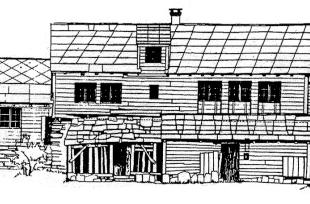As early as in the 1300s Aga was divided into an “upper yard” and a “lower yard”. The houses were placed in groups on either side of a road, and each yard had its grand house, a smokehouse of unusual dimensions. This house was pulled down in 1811, but Lagmannsstova is still standing. From written sources we see that the “upper yard” is mentioned in 1398 (DN VIII); in the 1500s there were three users at Aga, and in the 1600s six, three in each part. In 1701 the users had become owner occupiers, and in 1907 nine freeholding farmers and 16 smallholders lived in the settlement.
The country policeman and representative at the Storting, Johannes Pedersen Aga, has described the demolished smokehouse, that contained timber with lengths of around 24 feet with a thickness of more than 2 feet. The building was in various places “decorated with sculptures”. Judging from the descriptions, this house has been constructed with a loft with roomy areas around, storage rooms and covered passageways. A stave-build chapel, situated south of “Lagmannsstova” was also pulled down – the church for the prominent people at Aga.




